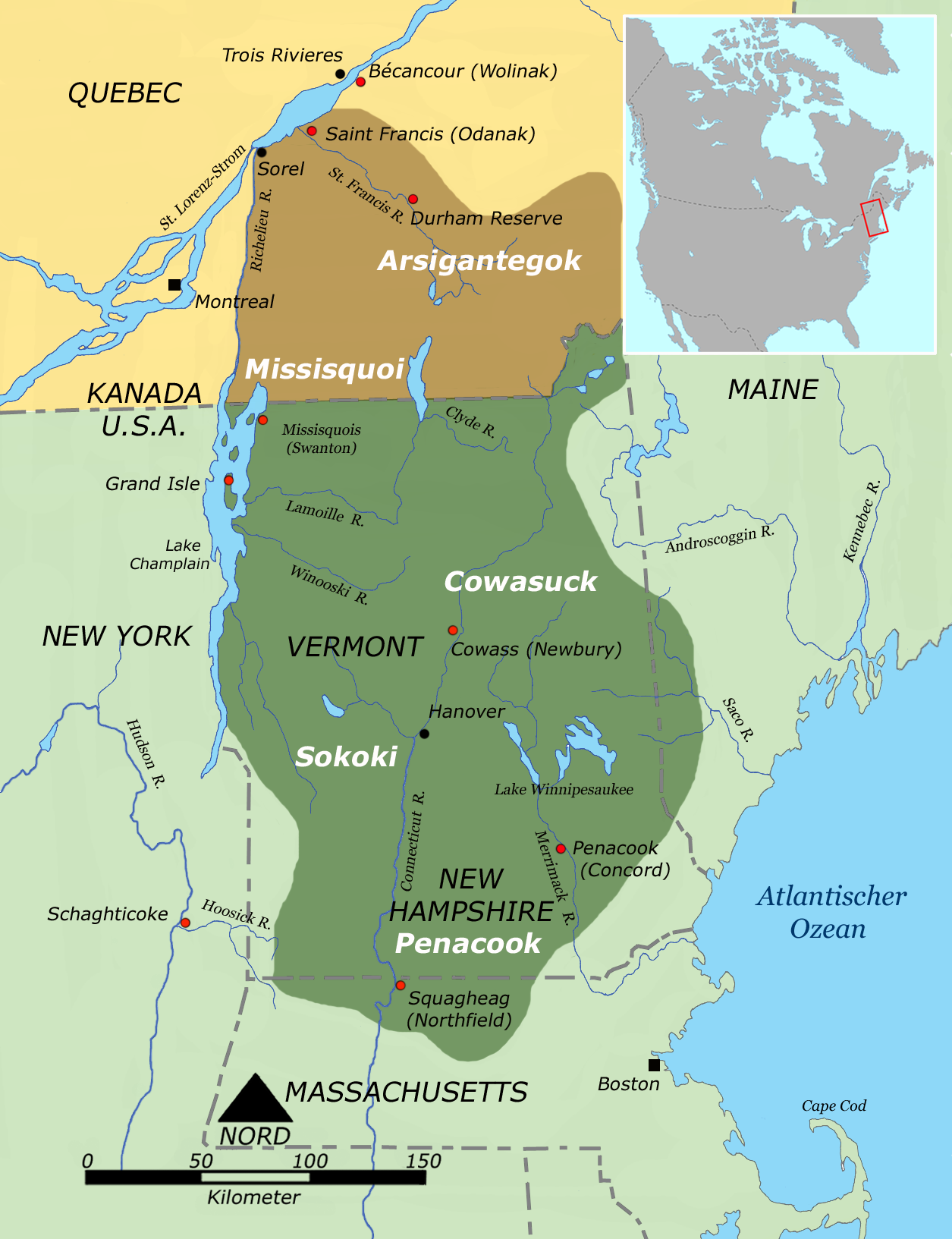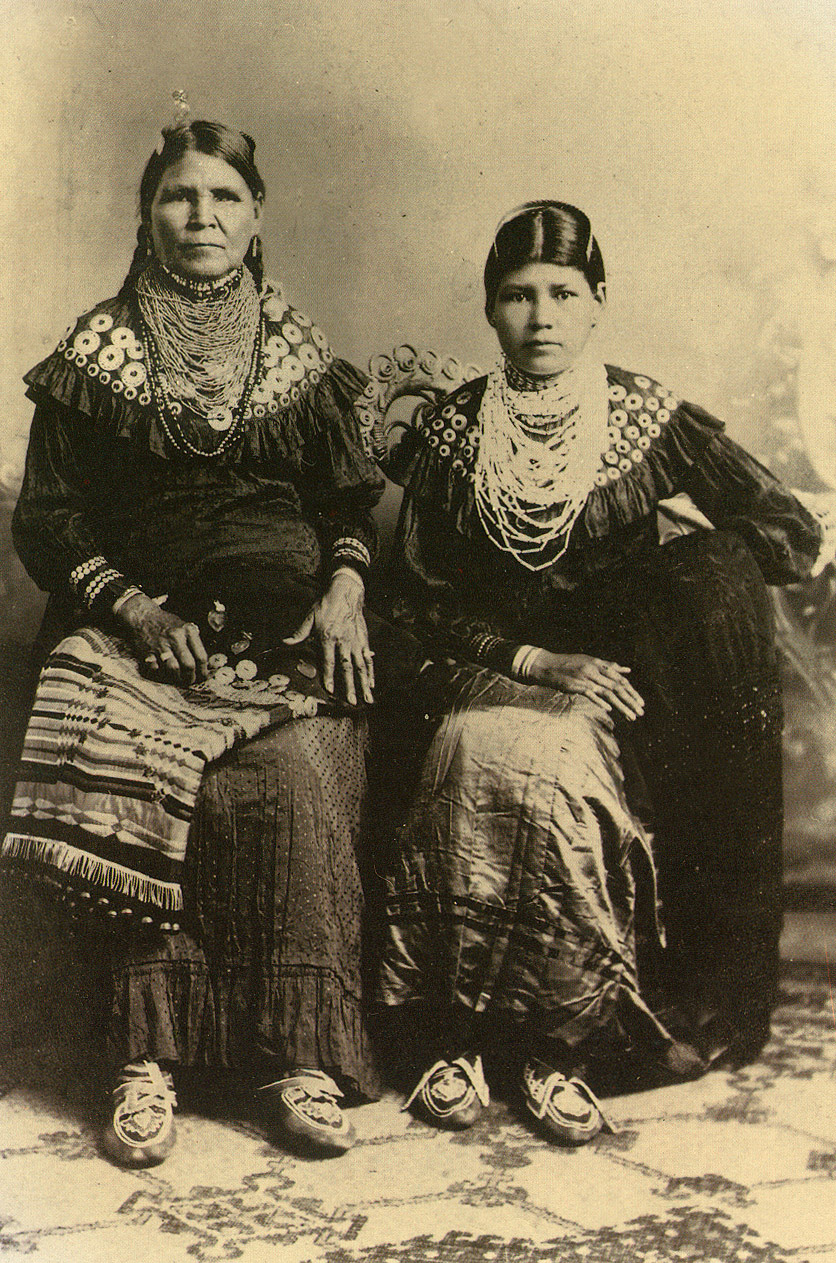|
Abenaki People
The Abenaki (Abenaki language, Abenaki: ''Wαpánahki'') are Indigenous peoples of the Northeastern Woodlands, Indigenous people of the Northeastern Woodlands of Canada and the United States. They are an Algonquian languages, Algonquian-speaking people and part of the Wabanaki Confederacy. The Eastern Abenaki language was predominantly spoken in Maine, while the Western Abenaki language was spoken in Quebec, Vermont, and New Hampshire. While Abenaki peoples have shared cultural traits, they did not historically have a centralized government. They came together as a post-contact community after their original tribes were Genocide of indigenous peoples, decimated by colonization, disease, and warfare. Names The word ''Abenaki'' and its syncope (phonology), syncope, ''Abnaki,'' are both derived from ''Wabanaki'', or ''Wôbanakiak,'' meaning "People of the Dawn Land" in the Abenaki language. While the two terms are often confused, the Abenaki are one of several tribes in the Waban ... [...More Info...] [...Related Items...] OR: [Wikipedia] [Google] [Baidu] |
Quebec
Quebec is Canada's List of Canadian provinces and territories by area, largest province by area. Located in Central Canada, the province shares borders with the provinces of Ontario to the west, Newfoundland and Labrador to the northeast, New Brunswick to the southeast and a coastal border with the territory of Nunavut. In the south, it shares a border with the United States. Between 1534 and 1763, what is now Quebec was the List of French possessions and colonies, French colony of ''Canada (New France), Canada'' and was the most developed colony in New France. Following the Seven Years' War, ''Canada'' became a Territorial evolution of the British Empire#List of territories that were once a part of the British Empire, British colony, first as the Province of Quebec (1763–1791), Province of Quebec (1763–1791), then Lower Canada (1791–1841), and lastly part of the Province of Canada (1841–1867) as a result of the Lower Canada Rebellion. It was Canadian Confederation, ... [...More Info...] [...Related Items...] OR: [Wikipedia] [Google] [Baidu] |
Syncope (phonology)
In phonology, syncope (; from ) is the loss of one or more sounds from the interior of a word, especially the loss of an unstressed vowel. It is found in both synchronic and diachronic analyses of languages. Its opposite, whereby sounds are added, is epenthesis. Synchronic analysis Synchronic analysis studies linguistic phenomena at one moment of a language's history, usually the present, in contrast to diachronic analysis, which studies a language's states and the patterns of change across a historical timeframe. In modern languages, syncope occurs in inflection, poetry, and informal speech. Inflections In languages such as Irish and Hebrew, the process of inflection can cause syncope: Verbs: * Irish: (to play) should become * (I play). However, the addition of the causes syncope and the second-last syllable vowel is lost so becomes . * Hebrew: (katav), (he) wrote, becomes (katvu), (they) wrote, when the third-person plural ending (-u) is added. Nouns: * Iris ... [...More Info...] [...Related Items...] OR: [Wikipedia] [Google] [Baidu] |
Newbury (village), Vermont
Newbury is an incorporated village in the town of Newbury in Orange County, Vermont, United States. The population was 447 at the 2020 census. History Newbury village was settled in 1763, and was along with neighboring Haverhill, New Hampshire, the first colonial settlement north of Charlestown, New Hampshire on the Connecticut River. The area developed because of the rich agricultural possibilities afforded by broad oxbows in the river. The village developed in the 19th century as a local market center and as a stagecoach stop. Its population was boosted by the found of the Newbury Seminary in the 1830s. The core of the village is listed as a historic district known as Newbury Village Historic District on the National Register of Historic Places. It was listed for its architectural significance in 1983. The historic village core around the village green includes 93 contributing buildings in an area of . Newbury Village is significant as a concentration of early 19th ce ... [...More Info...] [...Related Items...] OR: [Wikipedia] [Google] [Baidu] |
Connecticut River
The Connecticut River is the longest river in the New England region of the United States, flowing roughly southward for through four states. It rises 300 yards (270 m) south of the U.S. border with Quebec, Canada, and discharges into Long Island Sound between Old Saybrook, Connecticut, Old Saybrook and Old Lyme, Connecticut. Its watershed encompasses , covering parts of five U.S. states and one Canadian province, via 148 tributaries, 38 of which are major rivers. It produces 70% of Long Island Sound's fresh water, discharging at per second. The Connecticut River Valley is home to some of the northeastern United States' most productive farmland, as well as the Hartford–Springfield, Hartford–Springfield Knowledge Corridor, a metropolitan region of approximately two million people surrounding Springfield, Massachusetts, and Hartford, Connecticut. History The word "Connecticut" is a Corruption (linguistics), corruption of the Mohegan word ''quinetucket'' and Nipmuc word ''kw ... [...More Info...] [...Related Items...] OR: [Wikipedia] [Google] [Baidu] |
Cowasuck
The Cowasuck, also known as Cowass, was an Algonquian-speaking Native American tribe in northeastern North America and the name of their primary settlement. Linguistically and culturally the Cowasuck belonged to the Western Abenaki and the Wabanaki Confederacy. They were Western Abenaki who lived in and around the village of Cowass, which became Newbury, Vermont. Name The name ''Cowasuck'' comes from the Abenaki word ''Goasek'' which means "White Pines Place", an area near Newbury, Vermont. The members of the tribe were called Goasiak (singular: Goasi), which means "the people of the white pines". Variant spellings of the place name include ''Koés'' in French and ''Cohass'', ''Cohoss'', or ''Coos'' in English, and an alternate demonym is ''Cohassiac''. Coös County, the northernmost county in New Hampshire, derives from the Wôbanakiak word. Territory The Cowasuck formerly resided on the upper Connecticut River, with the main village of Cowasuck, now Newbury, located ... [...More Info...] [...Related Items...] OR: [Wikipedia] [Google] [Baidu] |
Odanak
Odanak is an Abenaki First Nations reserve in the Central Quebec region, Quebec, Canada. The mostly First Nations population as of the 2021 Canadian census was 481. The territory is located near the mouth of the Saint-François River at its confluence with the St. Lawrence River. It is partly within the limits of Pierreville and across the river from Saint-François-du-Lac. ''Odanak'' is an Abenaki word meaning "in the village". History Beginning about 1000 CE, Iroquoian-speaking people settled along the St. Lawrence River, where they practiced agriculture along with hunting and fishing. Archeological surveys have revealed that by 1300, they built fortified villages similar to those seen and described by French explorer Jacques Cartier in the mid-16th century, when he visited Hochelaga and Stadacona. However, by 1600, the villages and people were gone. Since the 1950s, historians and anthropologists have used archeological and linguistic evidence to develop a consensus ... [...More Info...] [...Related Items...] OR: [Wikipedia] [Google] [Baidu] |
Saint-François River
The Saint-François River (, ) is a right tributary of the St. Lawrence River in Quebec, Canada. Its source is Lake Saint-François in Chaudière-Appalaches, southeast of Thetford Mines. It flows southwest towards Sherbrooke, where it changes course northwest towards Drummondville, and finally empties into the Saint Lawrence River near Pierreville. Its total length is 135 miles. Etymology The river is named after Saint Francis Xavier (1506–1552) by the Jesuits, who explored the region under the French regime, and after François de Lauzon.François de Lauzon (1635-1647 or 1648), son of Jean de Lauzon Geography Its course is also unusual, as it flows from northeast to southwest to branch off, halfway through, and continue its course from southeast to northwest. The Saint-François River has its origins in the lake Saint-François and heads southwest towards Sherbrooke. Along the way, it crosses the lakes Lake Aylmer and Lake Louise as well as many municipalities. I ... [...More Info...] [...Related Items...] OR: [Wikipedia] [Google] [Baidu] |
Androscoggin People
The Androscoggin (Ammoscongon) were an Abenaki people from what are now the U.S. states of Maine and New Hampshire. By the 18th century, they were absorbed by neighboring tribes. Name The name of the Androscoggin is derived from an anglicization of the Abenaki-language term Ammoscongon, which was the name given for the portion of the Androscoggin River from Lewiston Falls northward, as stated by Pere Pole in 1793. Distribution The Ammoscongon once lived in the Androscoggin River watershed, located in present-day southern Maine and northern New Hampshire. Their main village was located in the vicinity of present-day Lewiston, Maine. Together with the Pigwacket near Fryeburg, Maine they formed the southernmost of the Abenaki tribes and were therefore one of the first in contact with the English colonists of New England. History 17th century In 1675, the Androscoggin took part in King Philip's War. The renowned hunter, trapper, fisherman and guide, Metallak (1727–1847), w ... [...More Info...] [...Related Items...] OR: [Wikipedia] [Google] [Baidu] |
Endonym And Exonym
An endonym (also known as autonym ) is a common, name for a group of people, individual person, geographical place, language, or dialect, meaning that it is used inside a particular group or linguistic community to identify or designate themselves, their place of origin, or their language. An exonym (also known as xenonym ) is an established, ''non-native'' name for a group of people, individual person, geographical place, language, or dialect, meaning that it is used primarily outside the particular place inhabited by the group or linguistic community. Exonyms exist not only for historico-geographical reasons but also in consideration of difficulties when pronouncing foreign words, or from non-systematic attempts at transcribing into a different writing system. For instance, is the endonym for the country that is also known by the exonyms ''Germany'' and in English and Italian, respectively, and in Spanish and French, respectively, in Polish, and and in Finni ... [...More Info...] [...Related Items...] OR: [Wikipedia] [Google] [Baidu] |
Lenape
The Lenape (, , ; ), also called the Lenni Lenape and Delaware people, are an Indigenous peoples of the Northeastern Woodlands, Indigenous people of the Northeastern Woodlands, who live in the United States and Canada. The Lenape's historical territory included present-day northeastern Delaware, all of New Jersey, the eastern Pennsylvania regions of the Lehigh Valley and Northeastern Pennsylvania, and New York Bay, western Long Island, and the lower Hudson Valley in New York (state), New York state. Today communities are based in Oklahoma, Wisconsin, and Ontario. During the last decades of the 18th century, European settlers and the effects of the American Revolutionary War displaced most Lenape from their homelands and pushed them north and west. In the 1860s, under the Indian removal policy, the Federal government of the United States, U.S. federal government relocated most Lenape remaining in the Eastern United States to the Indian Territory and surrounding regions. The la ... [...More Info...] [...Related Items...] OR: [Wikipedia] [Google] [Baidu] |
Delaware Languages
The Delaware languages, also known as the Lenape languages (), are Munsee and Unami, two closely related languages of the Eastern Algonquian subgroup of the Algonquian language family. Munsee and Unami were spoken aboriginally by the Lenape people in the vicinity of the modern New York City area in the United States, including western Long Island, Manhattan Island, Staten Island, as well as adjacent areas on the mainland: southeastern New York State, eastern Pennsylvania, New Jersey, Connecticut, Maryland, and Delaware. Classification The Lenape language is part of the Algonquian branch of the Algic language family, and is part of the Eastern Algonquian language grouping which is considered to be a genetically related sub-grouping of Algonquian. The languages of the Algonquian family constitute a group of historically related languages descended from a common source language, Proto-Algonquian, which was descended from Algic. The Algonquian languages are spoken across Can ... [...More Info...] [...Related Items...] OR: [Wikipedia] [Google] [Baidu] |




